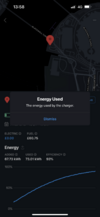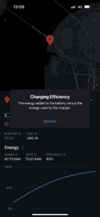Hello, wonder if there are any nerds on here that can comment on a question that has been bugging me for a little while. I have the Tesla Wall Connector and generally charge at the full 32 amps. However I have noticed that the voltage showing on the app is about 220V when charging at 32 amps, but increases to about 230V when the current is dropped to 16A or below. So is there any change to the efficiency losses at different currents? i.e would there be any benefit to charge up overnight for 10 hours at 10A say than 3 hours at 32A? (Would it help if the battery is just completing its charge first thing in the morning before using - would it have added any heat into it at such a low current to help optimise driving efficiency?)
Welcome to Tesla Motors Club
Discuss Tesla's Model S, Model 3, Model X, Model Y, Cybertruck, Roadster and More.
Register
Install the app
How to install the app on iOS
You can install our site as a web app on your iOS device by utilizing the Add to Home Screen feature in Safari. Please see this thread for more details on this.
Note: This feature may not be available in some browsers.
-
Want to remove ads? Register an account and login to see fewer ads, and become a Supporting Member to remove almost all ads.
You are using an out of date browser. It may not display this or other websites correctly.
You should upgrade or use an alternative browser.
You should upgrade or use an alternative browser.
Charging efficiency question
- Thread starter T3SSY
- Start date
ElectricIAC
Good-Natured Rascal
Jason71
Well-Known Member
At a certain point higher amps = more excess heat = lower efficiency but I doubt the difference between 10 and 32 amps is going to be significant though in practice in a system designed to deal with 600amps (250kw@400v). AC charging is all basically trickle charging as far as the car is concerned
On the other hand charging at 10 amps is going to take 3 times as long so the car has to be awake 3 times longer and the battery temp ( in cold weather) has to be maintained for 3 times as long and I would have thought on balance that that would be less efficient.
On the other hand charging at 10 amps is going to take 3 times as long so the car has to be awake 3 times longer and the battery temp ( in cold weather) has to be maintained for 3 times as long and I would have thought on balance that that would be less efficient.
NewbieT
Active Member
Also, at 10 Amps the energy used to warm the battery in cold weather becomes significant compared to the charge added to the battery.
Jason71
Well-Known Member
Should also add that we know that 10amp charging with a UMC is around 5% LESS efficient than using a 32amp charger based on peoples experience but since that is a different device that does not necessarily translate into charging at 10amps with a wall charger but just mentioning it...
Country Boy
Member
Another thing to think about.. the overhead of having the car awake while charging.
I think the car uses about 400w as self consumption when turned on to power the computers and other services. So this needs to be deducted from the charge rate of the EVSE. A granny charger is 10A, or 2300 isa watts. After losses, a little less than 2kW going into the battery. 32A charging, and the 400w is much less significant.
I too get a drop in voltage on the app at higher charge rates. This too will reduce the efficiency of the charge, as there will be heating loses.
You pays your money, you take your choice.
I think the car uses about 400w as self consumption when turned on to power the computers and other services. So this needs to be deducted from the charge rate of the EVSE. A granny charger is 10A, or 2300 isa watts. After losses, a little less than 2kW going into the battery. 32A charging, and the 400w is much less significant.
I too get a drop in voltage on the app at higher charge rates. This too will reduce the efficiency of the charge, as there will be heating loses.
You pays your money, you take your choice.
Jason71
Well-Known Member
More like 250w but valid point.Another thing to think about.. the overhead of having the car awake while charging.
I think the car uses about 400w as self consumption when turned on to power the computers and other services. So this needs to be deducted from the charge rate of the EVSE. A granny charger is 10A, or 2300 isa watts. After losses, a little less than 2kW going into the battery. 32A charging, and the 400w is much less significant.
I too get a drop in voltage on the app at higher charge rates. This too will reduce the efficiency of the charge, as there will be heating loses.
You pays your money, you take your choice.
Heat loss vs increased system overhead. Tough choices.
Lots of folks in various threads sure report a lot of voltage drop, and I think they're all using the app to get their data. I begin to wonder if there might be substantial voltage loss in Tesla EVSE's. For that matter I wonder if the app is reporting the voltage as seen at the OBC or at the wall charger.
As I just shared in another thread, I drop 4v at the panel with 65 amps of load. That's using pretty well validated monitoring tools. So yea, my service and panel seem to be right and tight, and I can deliver reasonable amounts of power at will. What will happen when I get my YLR and install a wall charger? Dunno. But I'll charge @ night so I'll never be seeing more then 4v of sag to the panel. Over a 60' run, terminated well, I should expect no more than 2.5V volts of loss using 6-6-6 SER at 48 amps of load. If I see more than 8V total loss as I measure at the end connection I'm going to think something is wrong with the circuit. If my tools say it's fine and the app shows it tapering down then I'm going to looking at Tesla. OBC or EVSE? Got no idea.

 www.cerrowire.com
www.cerrowire.com
All of which begats the question: "Who's metered their wall connection wiring during production to see what it's really doing at the end of the branch circuit?
Lots of folks in various threads sure report a lot of voltage drop, and I think they're all using the app to get their data. I begin to wonder if there might be substantial voltage loss in Tesla EVSE's. For that matter I wonder if the app is reporting the voltage as seen at the OBC or at the wall charger.
As I just shared in another thread, I drop 4v at the panel with 65 amps of load. That's using pretty well validated monitoring tools. So yea, my service and panel seem to be right and tight, and I can deliver reasonable amounts of power at will. What will happen when I get my YLR and install a wall charger? Dunno. But I'll charge @ night so I'll never be seeing more then 4v of sag to the panel. Over a 60' run, terminated well, I should expect no more than 2.5V volts of loss using 6-6-6 SER at 48 amps of load. If I see more than 8V total loss as I measure at the end connection I'm going to think something is wrong with the circuit. If my tools say it's fine and the app shows it tapering down then I'm going to looking at Tesla. OBC or EVSE? Got no idea.

Cerrowire Resources - Ampacity Charts
Ampacity is the maximum current that a conductor can carry continuously under the conditions of use without exceeding its temperature rating. Cerrowire's ampacity chart helps calculate the load requirement for a circuit.
All of which begats the question: "Who's metered their wall connection wiring during production to see what it's really doing at the end of the branch circuit?
Sean.
Active Member
I've got a Gen2 Tesla wall connector metered through a Crompton DRS-100-3P so later in the morning (if I remember) I'll have a look at the voltage its reporting across the various phases, compared to car and app. when its goes on charge.All of which begats the question: "Who's metered their wall connection wiring during production to see what it's really doing at the end of the branch circuit?
Sean.
Active Member
In *general* with switch mode type converters (like the one in the car AC->DC) there will be a sweet spot in their internal efficiency when they’re running somewhere between 70 and 90% of their rated load. So the higher you push them the better they are. All else being equal they will be less efficient at lower amperage. Hence a granny charger running off a domestic socket won’t be anywhere near as efficient as a 7 / 11 or 22 kW tethered supply.So is there any change to the efficiency losses at different currents? i.e would there be any benefit to charge up overnight for 10 hours at 10A say than 3 hours at 32A?
Interestingly when I supercharge or use a high power DC charger the net overall efficiency (as reported by Tessie app) is 93%. When I charge on a 22kW+ capable AC unit the efficiency is also the same at 93%.
So the AC to DC converters in the external high power EVSE are about as good as the AC/DC converter in the car.
Jason71
Well-Known Member
I don't think the Tessie app has access to data about the amount of AC consumed by the Supercharger, Don't think Tesla API's provide that information so surely the 93% in that case is the efficiency of cramming the high current DC into the battery. Energy lost as heat mainly, The missing 7% may also include energy used by the car while supercharging, I have no idea.In *general* with switch mode type converters (like the one in the car AC->DC) there will be a sweet spot in their internal efficiency when they’re running somewhere between 70 and 90% of their rated load. So the higher you push them the better they are. All else being equal they will be less efficient at lower amperage. Hence a granny charger running off a domestic socket won’t be anywhere near as efficient as a 7 / 11 or 22 kW tethered supply.
Interestingly when I supercharge or use a high power DC charger the net overall efficiency (as reported by Tessie app) is 93%. When I charge on a 22kW+ capable AC unit the efficiency is also the same at 93%.
So the AC to DC converters in the external high power EVSE are about as good as the AC/DC converter in the car.
The AC charging efficiency will be largely the losses in AC/DC conversion as you say
So I don't think you are comparing like with like
An interesting tidbit is that the Tesla allows you to measure the resistance of your wiring. Write down the voltage at the lowest charge current and at the highest, then do the calculation according to Ohm's Law.
As to the original question: Charge at a high current. The loss due to voltage sag, 4.3% in your case, is lower than the loss due to other inefficiencies.
As to the original question: Charge at a high current. The loss due to voltage sag, 4.3% in your case, is lower than the loss due to other inefficiencies.
Sean.
Active Member
I’ll have a look at the power meter on the wall connector and see what it tells me. It’s MID compliant so should be pretty accurate as a comparison to the app.I don't think the Tessie app has access to data about the amount of AC consumed by the Supercharger, Don't think Tesla API's provide that information so surely the 93% in that case is the efficiency of cramming the high current DC into the battery. Energy lost as heat mainly, The missing 7% may also include energy used by the car while supercharging, I have no idea.
The AC charging efficiency will be largely the losses in AC/DC conversion as you say
So I don't think you are comparing like with like
Jason71
Well-Known Member
Not sure how that relates to my point that SuC AC consumption is not available in the Api? .I’ll have a look at the power meter on the wall connector and see what it tells me. It’s MID compliant so should be pretty accurate as a comparison to the app.
It is avalable for other DC chargers that is what they bill by. Compare AC billed to DC added to battery if you want a true figure (but don't sit in the car with heating on while doing it)
Sean.
Active Member
Yes that would be for an AC based charge.Not sure how that relates to my point that SuC AC consumption is not available in the Api? .
It is avalable for other DC chargers that is what they bill by. Compare AC billed to DC added to battery if you want a true figure (but don't sit in the car with heating on while doing it)
On the DC based charge:
Last SuC yesterday. The Tesla app reported 69 kWh. Presumably that is the ‘net’ DC based energy figure delivered to the car (after SuC AC to DC conversion) rather than the ‘gross’ AC energy figure used by the SuC unit.
The Tessie app reported 73.01 kWh “used” and 67.73 kWh “added”.
So to my mind that’s a Supercharger AC to DC conversion efficiency of 94.5% (69/73.01) and DC charging into the pack of 98% (67.73/69) for a total overall efficiency of 92.9% (67.73/73.01)
Last edited:
Jason71
Well-Known Member
I believe that to be the case yesYes that would be for an AC based charge.
On the DC based charge:
Last SuC yesterday. The Tesla app reported 69 kWh. Presumably that is the ‘net’ DC based energy figure delivered to the car (after SuC AC to DC conversion) rather than the ‘gross’ AC energy figure used by the SuC unit.
The added yes I agree that would be what was added to the battery. Probably comes from the "charge_energy_added" value in the charge state API.The Tessie app reported 73.01 kWh “used” and 67.73 kWh “added”.
but as for the 73.01 I have no idea where that comes from and I don't know of anything in the API that equates to the AC provided by a supercharger so I am not convinced it is what you think it is.
Sean.
Active Member
I believe that to be the case yes
The added yes I agree that would be what was added to the battery. Probably comes from the "charge_energy_added" value in the charge state API.
but as for the 73.01 I have no idea where that comes from and I don't know of anything in the API that equates to the AC provided by a supercharger so I am not convinced it is what you think it is.


Jason71
Well-Known Member
I believe it says it I am just not convinced its right since I can't figure out where its coming from and I am like that
If it matches the figure you are billed for at a non Tesla DC charger then fair enough I guess its right.
Similar threads
- Replies
- 7
- Views
- 858
- Replies
- 2
- Views
- 414
- Replies
- 9
- Views
- 872
- Replies
- 8
- Views
- 394
- Replies
- 22
- Views
- 2K


